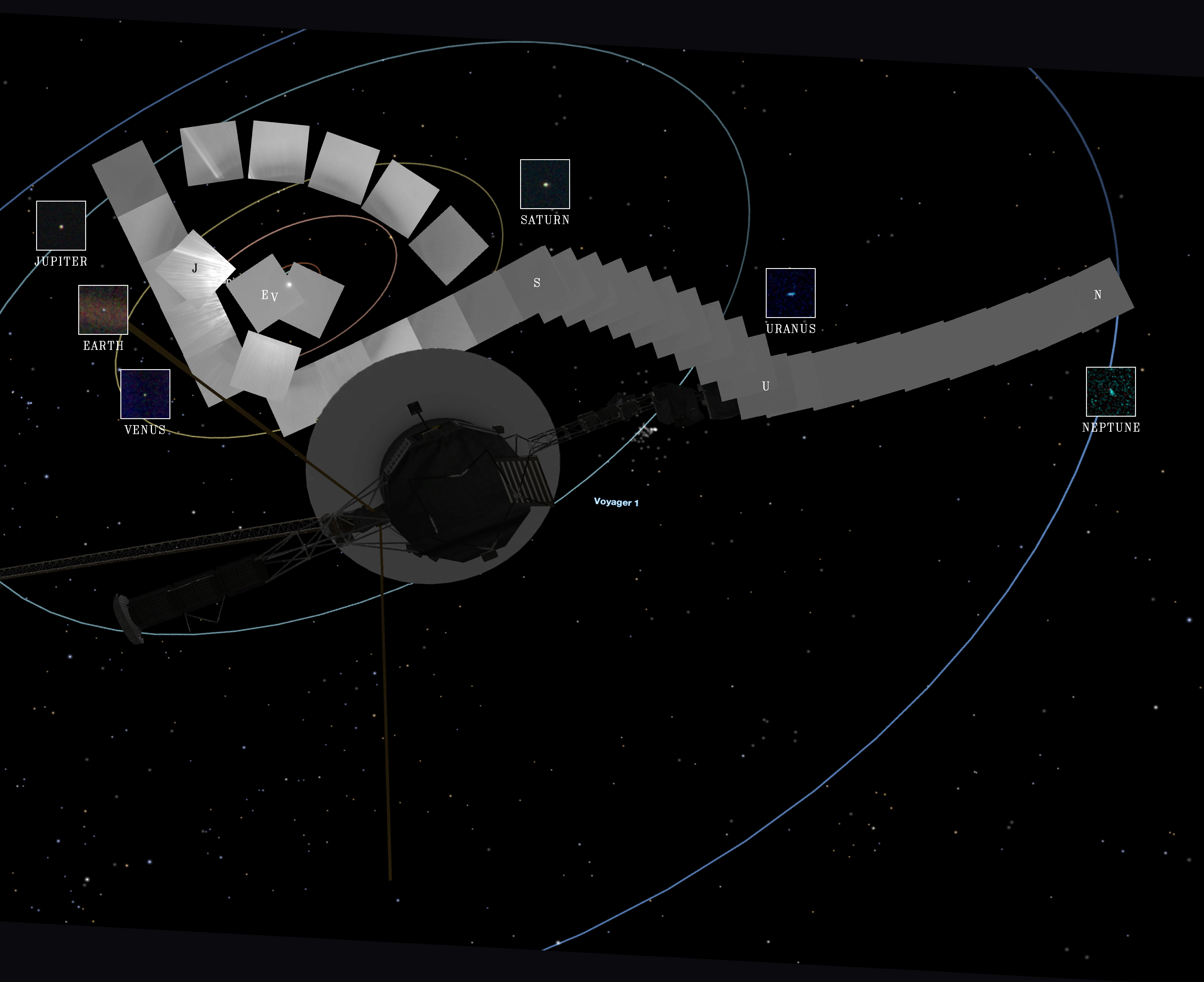Iconic Image
Voyager 1's Pale Blue Dot
This iconic image of the Earth, dubbed 'Pale Blue Dot', is a part of the first ever 'portrait' of the solar system taken by Voyager 1.
What is the Pale Blue Dot?
The Pale Blue Dot is an iconic photograph of Earth taken on Feb. 14, 1990, by NASA’s Voyager 1 spacecraft.

Voyager 1 was speeding out of the solar system — beyond Neptune and about 3.7 billion miles (6 billion kilometers) from the Sun — when mission managers commanded it to look back toward home for a final time. It snapped a series of 60 images that were used to create the first “family portrait” of our solar system.
The picture that would become known as the Pale Blue Dot shows Earth within a scattered ray of sunlight. Voyager 1 was so far away that — from its vantage point — Earth was just a point of light about a pixel in size.

The Family Portrait
In addition to Earth, Voyager 1 captured images of Neptune, Uranus, Saturn, Jupiter, and Venus. A few key members didn’t show up in the shot: Mars was obscured by scattered sunlight bouncing around in the camera, Mercury was too close to the Sun, and dwarf planet Pluto was too tiny, too far away and too dark to be detected.
The images gave humans an awe-inspiring and unprecedented view of their home world and its neighbors. Like Earth, each planet appears as just a speck of light (Uranus and Neptune appear elongated due to spacecraft motion during their 15-second camera exposures).
Finding a way to display the images and capture the sheer scale of Voyager’s accomplishment proved challenging. NASA’s Jet Propulsion Laboratory — which built and manages the Voyager probes — mounted the entire mosaic on a wall in its Theodore von Kármán Auditorium and it covered over 20 feet.
Members of the Voyager imaging team said in a 2019 research paper that the image of Earth had to be replaced often because so many people touched it.
The family portrait remains the first and only time a spacecraft has attempted to photograph our home solar system. Only three spacecraft have been capable of making such an observation from such a distance: Voyager 1, Voyager 2 and New Horizons.
Sagan’s Dream Shot
Sagan played a leading role in the U.S. space program. The prominent planetary scientist was a consultant and adviser to NASA beginning in the 1950s. He briefed the Apollo astronauts before their flights to the Moon.
In his role as a visiting scientist at JPL, Sagan helped design and manage the Mariner 2 mission to Venus; the Mariner 9, Viking 1 and Viking 2 trips to Mars; the Voyager 1 and Voyager 2 missions to the outer solar system and the Galileo mission to Jupiter.
Sagan also was a member of the Voyager Imaging Team. He had the original idea in 1981 to use the cameras on one of the two Voyager spacecraft to image Earth. He realized that because the spacecraft were so far away the images might not show much. This was precisely why Sagan and other members of the Voyager team felt the images were needed — they wanted humanity to see Earth’s vulnerability and that our home world is just a tiny, fragile speck in the cosmic ocean.
On Feb. 13, 1990, Voyager 1 warmed up its cameras for three hours. Then the spacecraft’s science platform was pointed at Neptune and the observations began.
After Neptune, it took images of Uranus, Saturn, Mars, the Sun, and then Jupiter, Earth and Venus. The Earth images were taken at 04:48 GMT on Feb. 14, 1990, just 34 minutes before Voyager 1 powered off its cameras forever.
It took until May 1, 1990 — and four separate communications passes with NASA's Deep Space Network — for all the image data to finally arrive back on Earth. Voyager 1 had captured images of six of the seven planets targeted as well as the Sun.
About the Photographer
Voyager 1 was launched Sept. 5, 1977, just days after its twin — Voyager 2 — on Aug. 20. Because it was on a faster route to the mission's first encounter, at Jupiter, Voyager 1 overtook Voyager 2 on Dec. 15, 1977. (This was the reason for the order of their naming.)
Voyager 1 flew past Jupiter on March 5, 1979, and Saturn on Nov. 12, 1980.
After snapping the Pale Blue Dot and other “family photos,” — at 05:22 GMT, Feb. 14, 1990 — Voyager 1 powered off its cameras forever. Mission planners wanted to save its energy for the long journey ahead.
In August 2012, Voyager 1 entered interstellar space. It’s now the most distant human-made object ever.
The image was processed by JPL engineer and image processing enthusiast Kevin M. Gill with input from two of the image's original planners, Candy Hansen and William Kosmann.
